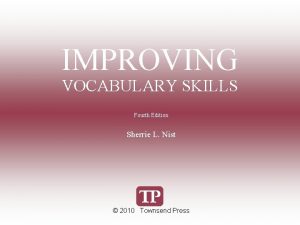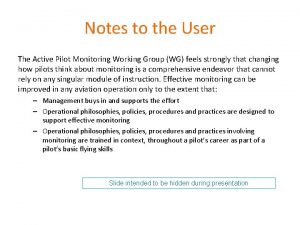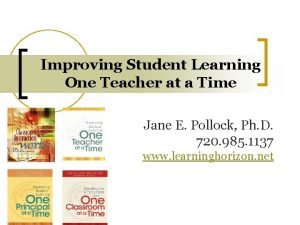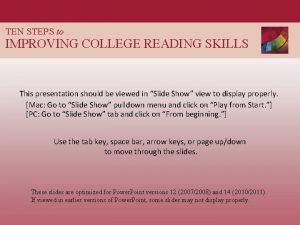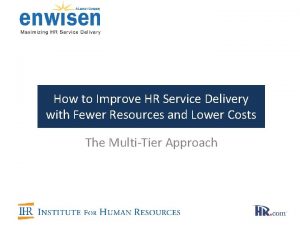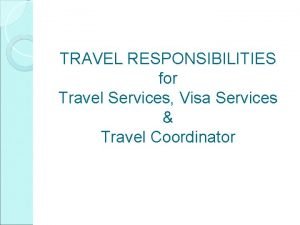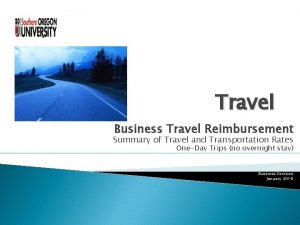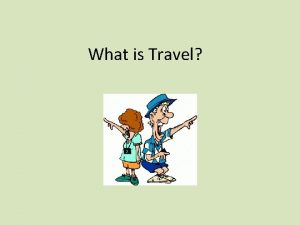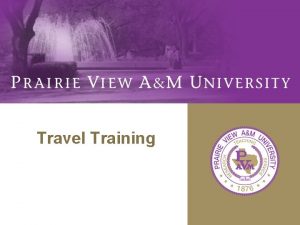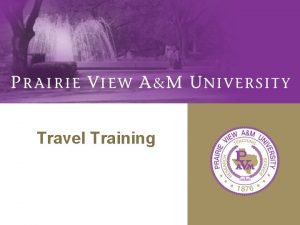Intrazonal or interzonal Improving intrazonal travel forecast in












- Slides: 12

Intrazonal or interzonal? Improving intrazonal travel forecast in a four‑step travel demand model Park, K. , Sabouri, S. , Lyons, T. , Tian, G. , and Ewing, R. Presented by: Reid Ewing Professor of City and Metropolitan Planning University of Utah ewing@arch. utah. edu Department of City & Metropolitan Planning, University of Utah www. company. com

Introduction Trip distribution: second step of conventional travel-demand models A major weakness of these models: inaccurate prediction of intrazonal trips Intrazonal trips are a minor consideration in the four-step travel demand modeling process, despite the fact that they typically amount to 10 percent or more of all trips in household travel surveys. Four Step Travel Demand Model (Adapted from Mc. Nally, 2007) Department of City & Metropolitan Planning, University of Utah www. company. com

State-of-the-Practice in Intrazonal Travel Modeling Results of a survey of 25 randomly selected (taking a stratified random sample) Metropolitan Planning Organizations (MPO): 1. The four-step process is still dominant. 2. Most commonly used models for estimating the trip distribution step: The gravity model, followed by the destination choice model 3. The gravity model with nearest neighbor assumptions about intrazonal travel times is still the dominant way of forecasting intrazonal trips. 4. Crude estimate of intrazonal travel time (nearest neighbor rule) Example: half of the average travel time to the four closest neighboring zones Department of City & Metropolitan Planning, University of Utah www. company. com

S e s s i o n Model Representation 6 : A n a l y t i c a l T o o l s www. company. com

S e s s i o n Sprawl Pattern 6 : A n a l y t i c a l T o o l s www. company. com

S e s s i o n Compact Pattern 6 : A n a l y t i c a l T o o l s www. company. com

Data and Method • 31 regions • 850, 000 trips • 91, 000 households • Trip mode, purposes • Trip ends XY • D variables for at household and TAZs Department of City & Metropolitan Planning, University of Utah www. company. com

Data and Method 3 -level binary logistic regression for each trip purpose Region, TAZ, Trips Variable Description Outcome Variable (level 1: trip) intrazonal trip remaining internal to TAZ (1=intrazonal, 0=interzonal) Explanatory Variables (level 2: TAZ) area gross land area of TAZ in square miles actden activity density within TAZ (pop+emp per square mile) entropy land use entropy within TAZ jobpop job-population balance within TAZ intden intersection density within TAZ pct 4 wy percentage of 4 -way intersections within TAZ stopden transit stop density within TAZ pctemp 10 a percentage of regional emp within 10 minutes by car pctemp 30 t percentage of regional emp within 30 minutes by transit totpop total population within TAZ totemp total employment within TAZ Explanatory Variables (level 3: region) regpop 000 Regional population in thousand regemp 000 Regional employment in thousand regpopden Regional population density (population per square mile) Department of City & Metropolitan Planning, University of Utah www. company. com

Model Results • Different D variables are shown to be significant predictors of intrazonal trips for different trip purposes. • Total employment (demographic variable) is positively associated with the share of intrazonal trips for all five trip purposes. • Total population (demographic variable) is positively associated with the share of intrazonal trips for home-based-shopping, home-based-other, and non-homebased-non-work purposes. • Area size has a positive association with the intrazonal trip likelihood for home-based-work, home-based-shopping, home-based-other, and non-homebased-non-work trips. Department of City & Metropolitan Planning, University of Utah www. company. com

Model Results • Activity density is positive and significant only in non-home-based-work model. • A land use diversity variable, job-population balance, is positively related to the share of intrazonal trips for all home-related trip purposes but home-based-work trips. • Destination accessibility—the percentage of jobs available within 10 -min, 20 -min, or 30 -min by car or 30 -min by transit—is negatively associated with the share of intrazonal trips for all five trip purposes. The more jobs immediately outside of the given TAZ, the more likely a trip crosses the zone boundary for specific trip types. • The percentage of four-way intersections—is positively associated with intrazonal trip likelihood only for home-based-shopping and non-home-based-work trips. • Lastly, regional variables are not statistically significant in any models, and so were dropped. Department of City & Metropolitan Planning, University of Utah www. company. com

Conclusion • Intrazonal trips cannot be ignored, due to the impact they have on important aspects of transportation, such as congestion and pollution. • We developed an approach to enhance the conventional gravity model for predicting intrazonal trips by including more built environment D variables and using a more robust modeling method. • The results of this study could be used in travel demand modeling practice, especially in the hundreds of medium- and small-sized MPOs. • Two regional MPOs, Wasatch Front Regional Council (WFRC) and Mountainland Association of Governments (MAG), are incorporating our models into their four-step models. • Estimation based on 31 region database: The models have external validity, and are generalizable for future changes on land use and transport toward more compact, mixed-use, and transit supportive developments. Department of City & Metropolitan Planning, University of Utah www. company. com

Thank You www. company. com
 Intrazonal and interzonal
Intrazonal and interzonal Ionization atomic absorption spectrophotomery
Ionization atomic absorption spectrophotomery Improving vocabulary with word parts and context clues
Improving vocabulary with word parts and context clues Empire 8284
Empire 8284 Improving software economics set 1
Improving software economics set 1 Improving student learning one teacher at a time
Improving student learning one teacher at a time Refactoring improving the design of existing code
Refactoring improving the design of existing code Ten steps to improving college reading
Ten steps to improving college reading Operating room turnover time
Operating room turnover time Improving chronic illness care model
Improving chronic illness care model Improving own learning and performance examples
Improving own learning and performance examples Transforming hr service delivery at kellogg
Transforming hr service delivery at kellogg Is drivers a verb
Is drivers a verb
